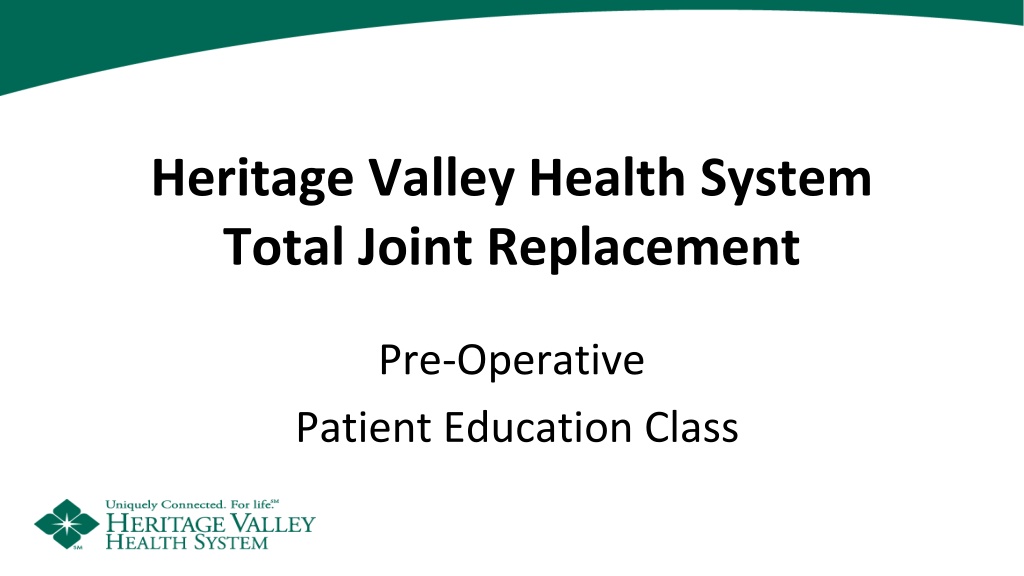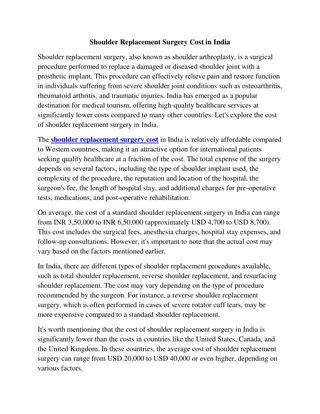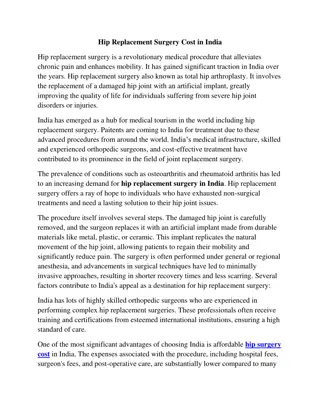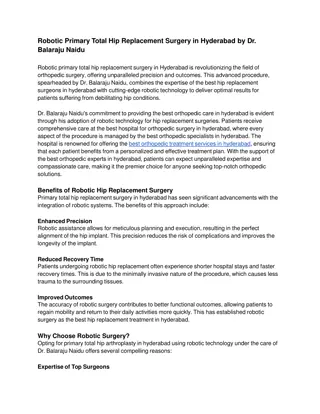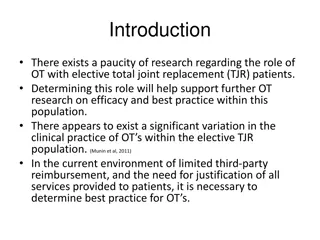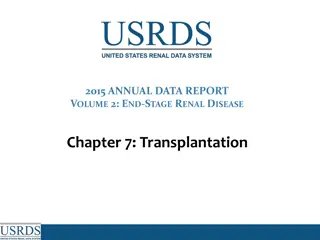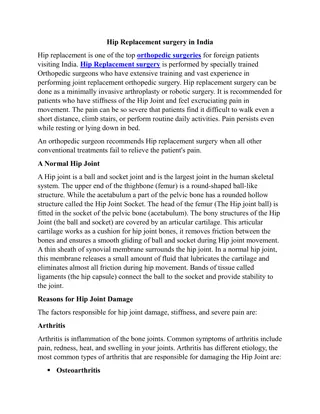Total Joint Replacement Pre-Op Education for Patients
Explore the comprehensive pre-operative patient education program at Heritage Valley Health System for total joint replacement surgeries. Learn about preparing for the procedure, pain management, physical therapy, and discharge planning. Find out about inpatient vs. outpatient status, understanding observation care, and how to prepare your home for surgery. Meet the orthopedic team and get ready for a successful joint replacement journey.
Download Presentation

Please find below an Image/Link to download the presentation.
The content on the website is provided AS IS for your information and personal use only. It may not be sold, licensed, or shared on other websites without obtaining consent from the author.If you encounter any issues during the download, it is possible that the publisher has removed the file from their server.
You are allowed to download the files provided on this website for personal or commercial use, subject to the condition that they are used lawfully. All files are the property of their respective owners.
The content on the website is provided AS IS for your information and personal use only. It may not be sold, licensed, or shared on other websites without obtaining consent from the author.
E N D
Presentation Transcript
Heritage Valley Health System Total Joint Replacement Pre-Operative Patient Education Class
Objectives for Total Joint Class How to prepare for your procedure What to expect during your hospital stay and expectations at home Pain Management Patient Safety Measures Physical & Occupational Therapy Discharge Planning Ease your anxiety and answer any questions!
The Orthopedic Team Surgeon Physician Assistant Orthopedic Clinical Navigator Registered Nurse Patient Care Associate Physical and Occupational Therapist Case Manager
Inpatient or Outpatient Status During your hospital stay, when the Surgeon admits you to the hospital, you may be admitted as an Inpatient or an Outpatient, also known as Observation Care The decision to admit as Inpatient or Outpatient is based on your diagnosis, level of care, services you need, and health care plan coverage As a patient, if you are unaware of your coverage as an Inpatient or Outpatient, please verify services with your insurance company prior to your procedure The difference between Inpatient and Outpatient/Observation Care is very important because it can affect how your health insurance covers these services
Understanding Observation Care at Heritage Valley Health System Patients in Outpatient/Observation Care will recover overnight in the hospital and receive the same high-level of care from doctors, nurses, and other health care professionals While in Observation Care, and depending on your benefits plan, you may be responsible for physician co-pays, deductibles or other out-of-pocket expenses During your hospital stay, please ask about your status and we will be happy to educate you and answer any of your questions!
Preparing Your Home Before Surgery Walkways and Stairs Clear any clutter from hallways and stairs Remove throw rugs Remove tripping hazards, such as extension and lamp cords Consider installing handrails for support Make sure rooms and hallways are well lit Utilize night lights
Preparing Your Home Before Surgery (Continued) Bathroom Home Base Install safety bars or a secure handrail in your shower or bath Use non-slip bath mats in bathroom Toilet seat risers with arms are essential for recovery and required for all total hip replacements Make note if there are surfaces to help pull you up to a standing position in your bathroom Decide where you will spend most of your day while you recover and place commonly used items within easy reach Move frequently used items to shelves and counters that are waist level Use a stable chair with a firm seat cushion and two arms for your early recovery It is easiest to stand from a seat that is higher than the back of your knees
Getting Ready for Your Surgery You will receive medical clearance from your Primary Care Physician (PCP) prior to your surgery If you have a Cardiologist, you may be required to have a clearance as well Complete testing ordered by your Surgeon to help plan your surgery Pre-operative testing should be completed prior to visiting your PCP for medical clearance A list of testing locations can be found at www.heritagevalley.org under the Services tab When you go to the exam, bring a list of all the medications and supplements, including herbs and vitamins, that you take Your Surgeon and PCP will advise you which medications you should stop or continue taking Notify your Surgeon if you develop any unexpected illness prior to your surgery Have dental care and routine cleanings done before surgery
Smoking Cessation Smoking affects the way your body handles surgery Do not use any products that contain nicotine or tobacco for at least 4 weeks before your procedure These products include cigarettes, chewing tobacco, and vaping devices When you stop smoking before surgery, you are giving your body the best opportunity to heal and reduce the risk of complications, such as infection and poor wound healing If you need help quitting, we are here to help and can offer resources to support your goal
Pre-Surgery Instructions Do not eat or drink anything after midnight the night before your procedure, unless instructed otherwise Do not drink any alcohol for at least 48 hours before surgery No gum, mints, lozenges or chewing tobacco Take all instructed medications on the morning of surgery with a sip of water May brush teeth morning of surgery
Medications that Increase Bleeding Discontinue all anti-inflammatory medications 7-10 days before surgery: Contact your prescribing MD or follow your Surgeon s instructions before discontinuing: Aspirin Motrin/Advil (Ibuprofen) Naproxen Aleve Mobic Celebrex Voltaren Herbal Medication and Vitamins such as Fish Oil or Vitamin E Coumadin Plavix Xarelto Pradaxa Effient Eliquis If you take any blood thinning medication and haven't been instructed to stop them, please contact the prescribing MD or your Surgeon
Arrange a Support System Arrange for a Coach or support system to assist you for several days when you go home It is extremely important to have assistance in place prior to your surgery During your hospital stay, they will be able to attend a Physical Therapy session with you Your designated Coach/support system should be available to: Provide you with transportation to and from the hospital Pick up any required medications ordered by your Surgeon Assist with tasks such as cooking, shopping, bathing, and laundry Take you to follow-up appointments Provide transportation to Outpatient Physical Therapy sessions
Pre-Surgical Phone Call A pre-surgical nurse at the hospital will contact you two business days prior to your surgery with specific instructions regarding your surgery The nurse will ask you the following questions: Medical and surgical history Allergies Vaccine/Immunization information Current medication list We recommend having a current medication list prepared for this phone call The nurse will also advise you what medications you should and shouldn t take on the morning of your surgery Provide the most up-to-date visitors policy to share with your support system. You may also visit www.heritagevalley.org for our visitation hours and policy.
Hospital Arrival Time Patients are typically required to be at the hospital two hours prior to their surgery start time You will need to contact the hospital or the hospital will contact you one business day prior to your procedure to obtain your hospital arrival time (Monday cases will call on the Friday before) Heritage Valley Beaver: (724) 773-7660 (Between 1:00 and 2:00 PM) Heritage Valley Kennedy: Will receive a phone call with arrival time Heritage Valley Sewickley: (412) 749-7310 (Between 1:30 and 2:30 PM)
Please Bring the Following Items with You: A list of medications that you take, including supplements (vitamins, herbal) Glasses/contacts, hearing aids, and dentures BiPap/CPAP Machine Living Will a copy is preferred Loose fitting, comfortable clothes for therapy A comfortable pair of shoes with non-slip soles Please feel free to pack specific toiletry products from home, such as toothbrush/paste, hair comb, etc. (The hospital will be able to provide essential toiletries, if needed) If you were notified regarding a required copayment for your surgery, please bring a form of payment (cash, check or credit cards are acceptable)
Additional Instructions Do not wear makeup, perfume, aftershave, hair products, jewelry (including body piercings), nail polish, skin creams, etc. Do not take any medication on the day of surgery unless instructed by your Surgeon, Primary Care Physician or hospital staff Do not bring medications to the hospital unless instructed by the pre-surgical nurse Cell phones and other devices are permitted during your stay The hospital offers free Wi-Fi Please note that the hospital is not responsible for any lost or stolen items
Pre-Operative Bathing Our skin harbors a multitude of bacteria Some bacteria protect us, but others can cause infection if they travel to a surgical site Bathe or shower using CHG Soap (Will either be provided in the office, a script will be given or can be purchased over-the-counter) Use the soap the night before your surgery and the morning of surgery, if time permits Please follow your Surgeon s instructions provided in the office Ensure you put on clean clothes, use clean towels, and sleep in clean sheets Do not shave anywhere near the operative site, as this will increase your risk of a wound infection Do not apply deodorant, lotions, creams or powder to any parts of your body after washing or showering with the CHG Soap
On the Day of Surgery You will be prepared for surgery in the Outpatient area Preparation for surgery includes: A visit with your Surgeon and an Anesthesiologist to discuss what type of anesthesia you will receive A visit with an RN who will: Take your vital signs, have you change into a gown and socks, place you in your hospital bed, start an IV, apply a sequential compression device (SCD) to non- operative leg, and wash the surgical area to help kill germs Questions will be asked repeatedly by different caregivers. This is for your safety to ensure the operative site and procedure are correct.
Types of Anesthesia General Anesthesia: Medicine is used to put you into a deep sleep throughout the entire procedure and a machine is used to help you breathe Spinal Anesthesia: Medicine is used to numb the lower part of your body while your sedated throughout the entire procedure and your able to breathe on your own The most common form of anesthesia being used is Spinal The anesthesia team will discuss these choices with you and help you decide which type of anesthesia is best for you
Surgical Procedure The surgical procedure time varies among each patient Typically will take approximately 1 to 1 Hours Your Orthopedic Surgeon will remove the damaged cartilage and bone, and then position new metal, plastic or ceramic joint surfaces to restore alignment and function of your new hip or knee Your designated support person will receive a full update from the Surgeon after surgery
Recovery Room (PACU) In the Recovery Room: After surgery, you will be moved to the Recovery Room where you will be closely monitored until you recover from anesthesia When you wake up you will be in your hospital bed The Recovery Room nurse will take your vital signs and scan your bladder and you may need a one-time catheterization After you awaken fully and are in stable condition, you will be taken to your hospital room You will be brought to the Orthopedic Specialty Unit located at: Heritage Valley Beaver: 4thFloor Heritage Valley Kennedy: 3rdFloor Heritage Valley Sewickley: 5thFloor
Designated Orthopedic Units In your room: You will meet your care team Your vital signs will be taken and you will be monitored closely Your IV fluids will usually be stopped the morning after surgery Staff Expertise Private room and bathroom for every patient Physical Therapy Gym During your hospital stay you will attend physical therapy in our physical therapy gym, which is located right on the Orthopedic Unit at your facility!
Post-Operative Nursing Care: What to Expect Bloodwork is drawn each morning to monitor your blood levels The morning after surgery, the staff will help you wash and dress in your room Staff will assist you when ambulating and getting to the restroom You are required to call for assistance every time you get up Safety is our number one priority!
Dietary Good nutrition before and after surgery is vital to your recovery and wound healing Avoid fried and greasy foods prior to your surgery If you are able to drink liquids with no nausea, you can eat immediately after surgery The Surgeon and Medical Doctor will enter a specific diet based on your medical history and the nurse will update you with your specific diet For meals, the dietary staff will call you on your hospital room phone for your order The nurse will assist you with all meal orders, if needed Be sure to drink plenty of fluids!
Pain Management Multimodal pain management approach Several different types of medications are utilized to manage your pain Intercept the pain; ask for medication when the pain starts to escalate; do not wait until the pain is severe Take your pain medication on a regular basis Tell the nurse if the medication is not effective Ask questions; be sure you understand the pain management efforts that are in place
Pain Pain in the hospital: Our nurses will ask you to rate your pain on a scale of 0 to 10. 0 is no pain, 10 is the worst pain imaginable It is important to let us know if you have pain and ask for pain medication It is also important to let us know how well your pain medicine is helping your pain Tips for pain control: Take your pain medicine before going to physical therapy, if needed Use ice on the surgical area as needed and after therapy Nurses will utilize the whiteboard to keep you updated on when your next dose of pain medication is available
Things to Remember about Pain We can t make the pain go away completely We aim to manage the discomfort so that you can eat, sleep, and perform physical therapy We do all we can to ensure your comfort and safety Being in unnecessary pain will cause stress on your body, tense your muscles and slow down your healing
Important Medical Information Surgery, pain medications and lack of mobility are contributors to constipation It is not uncommon to not have a bowel movement until the 2ndor 3rdday after surgery Stool softeners will be started on the day of surgery and will be administered twice a day Please notify your nurse or Surgeon if you feel additional measures should be taken Drink enough fluid to keep your urine clear or pale yellow
Activity Being active is an important part of healing and will begin immediately after your surgery Exercise by doing ankle pumps while in bed Foot and ankle movement will be encouraged following surgery to increase blood flow in your leg muscles It is important to have a balance between rest and activity No long periods of sitting or standing
Sequential Compression Device (SCD) SCD s are used to prevent blood clots: The sequential compression device (SCD) is made of two sleeves that fit around your calves and gently squeeze the leg muscles SCD s improve circulation by mimicking walking They should be worn when in bed and when resting Wear compression stockings (TED Hose) if instructed by your surgeon
Medications Medications to prevent blood clots: Blood thinners are used after surgery to prevent blood clots Commonly prescribed blood thinners include Aspirin, Coumadin, Lovenox, Xarelto or Eliquis Take your prescribed blood thinner medication as prescribed by your Surgeon and detailed on your discharge instructions
Preventing Pneumonia People who have surgery are at risk of developing pneumonia To avoid lung congestion after surgery, you should breathe deeply and cough frequently to clear your lungs The Incentive Spirometer is a hand-held device used to fully open your lungs and prevent congestion after surgery
Preventing Infection The most common cause of infection following surgery is from bacteria that enter the bloodstream during dental procedures, urinary tract infections, or skin infections You will be administered IV antibiotics pre- and post-operatively as a preventative measure Hand washing is the most important thing you can do to prevent infection Signs of Infection: Persistent Fever Shaking/Chills Increasing redness, tenderness or swelling of operative site Drainage from wound Increasing pain with both activity and rest Notify your surgeon immediately if you develop any of these signs!
Incisional Care Follow instructions from your health care provider about how to care for your incision This will be detailed on your discharge instructions and taught by your nurse Cover the incision with a clean dressing Ask your health care provider when you can begin leaving the incision uncovered You may not shower or bathe until it is approved by your surgeon Do not take baths, swim, use a hot tub or do anything that would put the incision under water until your health care provider approves Do not scratch or pick at the incision If your incision bleeds through the dressing and the bleeding does not stop with gentle pressure, please contact your Surgeon
Incisional Care (Continued) Your incision will need to be cared for properly to prevent infection Check your incision area every day for signs of infection, which include: More redness, swelling or pain around your incision More fluid or blood coming from your incision Warmth coming from your incision Pus or a bad smell coming from your incision A fever Swelling is not uncommon (even for several weeks after surgery) Use ice to help control pain and swelling; apply for 20-30 minutes at a time as needed Wash your hands with soap and water for at least 20 seconds before and after you change your dressing to prevent infection
Avoiding Falls A fall during the first few weeks after surgery can damage your new joint, and may result in a need for more surgery You should use a cane, crutches, walker, handrails or have someone help you until you improve your balance, flexibility, and strength A walker is often used for the first several weeks to help with your balance and avoid falls Your physical therapist during your hospital stay will help you decide which assistive walking devices and aids will benefit you following surgery
Types of Therapy Physical Therapy Occupational Therapy Will begin on post-operative day one, and will focus on precautions and activities of daily living Will educate you on how to become more independent with bathing and dressing yourself Will begin the day of surgery in your room with a Physical Therapist Teaches lower extremity strengthening and therapeutic exercises Walking with assistive devices
Physical Therapy You will then go to the Physical Therapy gym for therapy twice a day, a morning and an afternoon session, starting on the day after surgery! Physical Therapists will teach you specific exercises to strengthen your leg and restore movement. You will work on: Ambulation Transfers Functional Activities Using Stairs Exercises: Ankle pumps, quad sets, gluteal sets, short arc quads, and heel slides
Occupational Therapy The goal of Occupational Therapy is to independently perform activities of daily living: Dressing Bathing Getting in and out of bed Rising and lowering to various surfaces (car, toilet, bath, etc.)
Total Hip Precautions Anterior Approach No abduction of surgical leg Avoiding bringing knees apart and away from your body No extension of surgical leg Do not step past surgical leg when walking (lunging) Your body should follow your surgical leg No external rotation or extreme outward rotation of the surgical leg Keep toes of surgical leg straight ahead
Total Hip Precautions Posterior Approach Limit hip flexion to 90 degrees No sitting on low or overly soft furniture, use chairs with arms for support Knees should be below the hip No crossing legs Do not cross midline of body with surgical leg When in bed, keep pillow between legs No inward rotation of surgical leg Keep toes of surgical leg straight ahead
Total Knee Instructions Do Don t Complete required exercises at least twice a day as instructed by your Physical Therapist Put ice on your knee after exercising and as needed Walk frequently, with a walker, as tolerated and per your Surgeon s instructions Twist or pivot on operative knee while walking Kneel on operative knee Do not place any support devices under knee which will leave your knee in a bent position
Exercise Regular exercise to restore your hip or knee mobility and strength are important for your full recovery Your Surgeon and Physical Therapist may recommend that you exercise 20 to 30 minutes at least twice a day Keep active: Move around every hour during the day Completing the recommended exercise program will help with your recovery and post- operative pain
Stair Climbing and Descending After surgery, you will be permitted to go up and down stairs Stair climbing and descending will be taught by your Physical Therapist during your hospital stay At first, you will need a handrail for support and will be able to go only one step at a time Always lead up the stairs with your good knee/hip and down the stairs with your operated knee/hip Remember up with the good and down with the bad
Using a Front-Wheeled Walker After surgery, you will be required to utilize a front-wheeled walker for your safety and recovery The utilization of a front-wheeled walker will assist in restoring a natural gait It is important to use any assistive device correctly to avoid falls Your therapist will instruct you on the proper usage of all devices Wheeled walkers will be provided at discharge by your Physical Therapist and are usually covered in full by your insurance Arrange furniture for safe walking Move around your home with your hands out about 6 inches from your sides You will have enough room if you do not hit anything with your hands as you do this
Equipment Needs All of your equipment needs will be discussed during your hospital stay with your Case Manager and Physical Therapist Please consider purchasing adaptive equipment if you have a Total Hip Replacement which would include: A dressing stick, sock aid, long-handled shoe horn for putting on and taking off shoes and socks without bending your new hip, and a grabber tool that will allow you to grab objects These items can be purchased prior to your surgery or you may purchase a lower extremity dressing kit through our therapy department to take home with you Check with your insurance company for benefits coverage for all your equipment needs
